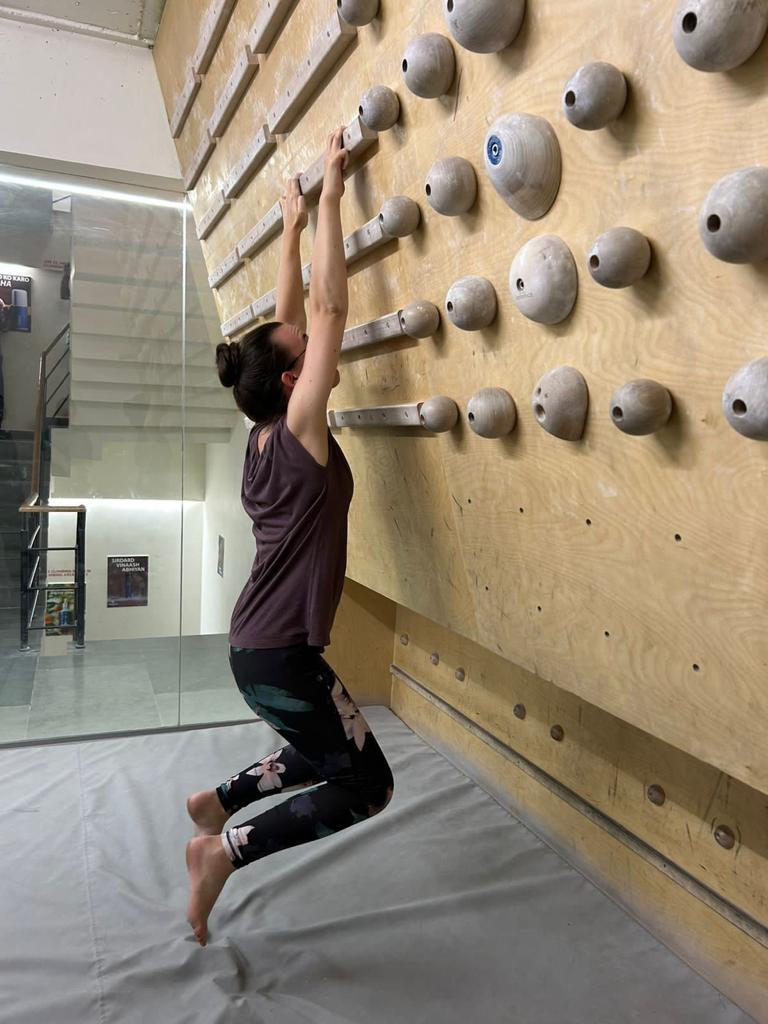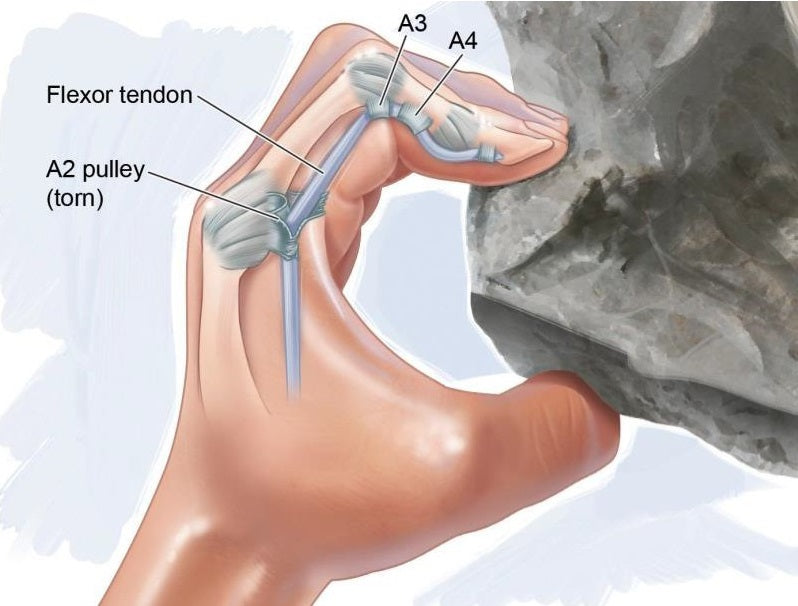Climbing - Injury Prevention and Management

October 09, 2023
065 views
Explore how climbers can reduce the risk of injuries with proper technique, cannabinoids and more.
Common climbing injuries and the techniques, tools and preparation required to reduce them.
Climbing in India
In recent years, climbing as a physical activity has picked up across the country. A new generation of urban fitness enthusiasts is taking to this sport, evident in the sprouting of dedicated climbing gyms which offer rock climbing and bouldering walls for beginners and experts alike. At the same time, outdoor climbing hotspots are emerging, from Nandi Hills outside Bengaluru, to the Aravalli Hills outside Delhi, to places like Sethan in Himachal and Suru Valley in Ladakh, and of course the mecca of Bouldering - Hampi.
Climbing is a physically demanding sport that builds, as well as requires, strength and balance. While starting off or taking up climbing more regularly, it’s important to listen to your body and take things slow because climbing comes with its fair share of common injuries. Fortunately, there is a lot of scope to improve when it comes to climbing injury prevention.

Finger Pulley Tears
Finger pulleys, also known as annular pulleys, keep the tendon that flexes the finger from "bow-stringing" away from the finger bone. Among these, the A2 pulley is one of the most commonly injured while climbing. Finger pulley tears are a unique injury specific to the sport of climbing, making them a common climbing injury prevention discussion point. The tears result from overloading a finger tendon with your body weight, typically during dynamic movements or when applying intense pressure while crimping holds. One of the distinct characteristics of a finger pulley tear is you will hear and feel an actual pop when the injury occurs.
Finger pulley tears are often caused by an ambitious climber attempting to support their body weight using the strength of their fingers. Instead, it is better to distribute load more evenly by engaging larger muscle groups, like your legs and core for support. Better climbing technique reduces the strain on your finger tendons and pulleys. Additionally, focusing on improving grip through finger strength training and gradually progressing to more challenging climbs builds finger strength and resilience. By using a combination of climbing techniques, muscle engagement, and finger strength training, you can significantly reduce the risk of finger pulley tears while climbing.
When dealing with a pulley injury, applying H-tape during the healing process, which can take between two to six weeks, can provide essential support, allowing some degree of movement while preventing excessive bending of the finger. This taping technique serves as a helpful reminder and guide, ensuring climbers don't overstrain their injured finger while still permitting controlled movement with the help of climbing gear and equipment.

Fall Injuries
Fall injuries in climbing encompass a range of physical consequences climbers might face. These injuries often include:
- Whiplash - Resulting from abrupt stops or swings
- Sprained wrists and arms - Occurs when climbers instinctively brace themselves upon impact
- Ankle sprains - Common when landing awkwardly
- Back pain - This may result from the jarring forces experienced during a fall
- Scraped arms and knees - Often due to contact with rocks and holds during descents
Notably, these injuries tend to affect the lower extremities more frequently. To minimize the risk of accidents, it's crucial to take off any jewellery or accessories that might get stuck on holds or equipment during your ascent. Additionally, it is crucial to inspect your landing zone before you start your climb or start any training exercises for climbers. Equally important is ensuring that no stray objects like screws, water bottles, or shoes are in your path.
Climbing inherently involves moments when you know you will fall. When this happens, it's essential to remember not to panic and instinctively grab for holds. Doing so can throw you off balance and increase the likelihood of fall injuries in climbers. Instead, try to fall with some level of control. Aim to land on the soles of your feet with your knees slightly bent, avoiding falls onto your ankles or toes. Climbing shoes, with their tense soles, make falling on your toes a risky proposition. Falling flat on your heel can also be problematic, potentially causing heel or back injuries. Maintaining relaxed yet slightly tightened muscles during a fall helps distribute the impact load and reduces the risk of fall injuries in climbers.
Achieving the right balance is critical in the world of climbing, even when it comes to falling. Muscles should be neither too relaxed nor overly tight. Finding this equilibrium ensures that the impact force is properly redistributed, significantly lowering the risk of injury upon landing and contributing to a well-rounded climbing injury prevention plan for climbers.

Shoulder Subluxation
Shoulder subluxation in climbers is a condition that climbers, especially those who engage in bouldering or make large overhead movements, should be aware of. It occurs when the shoulder's ball joint is extended too far forward, resulting in a sharp pain in the back of the shoulder. You need to stop your climb immediately if you face shoulder subluxation. To avoid this painful issue while climbing, it's crucial to work on grip strength with finger strength training to help with better control and stabilization during climbs. Additionally, paying attention to proper climbing techniques and avoiding overextending the shoulder joint can help prevent shoulder subluxation in climbers, which, if left unaddressed, may escalate to a more severe rotator cuff strain

Developing an Injury Prevention Plan
Developing and adhering to an injury prevention plan for climbers is paramount while enjoying the sport without the risk of debilitating injuries. This plan should encompass several key components:
- Static Stretches: Incorporating static stretching routines into your climbing regimen can enhance flexibility and reduce muscle tension. Stretching major muscle groups, especially the lower back, shoulders, and legs, can help maintain a full range of motion and prevent strains with the right training exercises for climbers.
- Antagonist Exercises for climbers: Balancing your strength is vital for injury prevention. Engage in antagonist exercises such as rowing, triceps presses, and wrist and finger extensions to counterbalance the muscles used in climbing. This ensures that one set of muscles doesn't become disproportionately strong, reducing the risk of overuse injuries.
- Dynamic Stretches: Dynamic stretching exercises should be performed as part of your warm-up routine before climbing. These movements help prepare your muscles and joints for the specific demands of climbing, enhancing circulation and mobility.
- Train Like You Climb: Incorporate climbing-specific training exercises into your routine to build strength and endurance tailored to the sport. Climbing gyms often provide training tools and setups that mimic the challenges faced on real climbing routes, providing easy access to training exercises for climbers.
- Correct Climbing Technique: Proper climbing technique is fundamental to preventing injuries. Understanding how to distribute your body weight, using your legs efficiently, and executing movements with precision not only enhances climbing performance but also reduces the risk of strains and tears.
- Adequate Recovery Time: Climbing can be physically demanding, and it's crucial to allow your body ample time to recover between sessions. Adequate rest helps muscles repair and strengthen, reducing the likelihood of overuse injuries.

Plant-based Medicines for Climbers
In any sporting activity, and in particular climbing, getting injured at one point or another is a given. Besides various modalities outlined above to minimise the risk of severe injury, climbers can incorporate novel natural product medicines - plant based pharmaceuticals - into their recovery and healing regimen. Cannabinoids, therapeutic compounds found in the cannabis plant, are proving especially efficacious in both pain management as well as in reducing inflammation. These are best used in a topical roll-on pain cream format for a post-workout application to stressed and painful tissue and joints in the fingers and metatarsals especially. Similarly, pain oils containing cannabinoid extracts and other synergistic ingredients such as arnica can be very beneficial in quickening the healing of tear injuries. It is important to choose medical products with proven efficacy and importantly those that have transdermal technology added into cream-based emulsions. A word of caution – professional athletes should refrain from using cannabinoid based phytoformulations, even if for topical application, given that cannabis medical compounds are still restricted by the World Anti-Doping Agency (WADA).
Reducing the Risk of Injury
Finally, incorporating warm-up routines, strength training, and using proper climbing gear and equipment ensures climbers are set up for success while reducing the risk of injuries. Hydration, recovery strategies like ice baths or showers, and adequate sleep are also crucial for overall well-being and facilitating healing when injuries do occur. The concept of periodization and off-season training provides essential recovery periods for sustained climbing performance. Lastly, the significance of quality climbing gear and equipment cannot be overstated, as well as the benefits of sports massages in alleviating tension and promoting circulation. Together, these modalities create a robust foundation for climbers to enhance their performance while pursuing their passion safely.
Buy Topical Cannabis Medicines Here
The event in the photos was conducted at Boulder Box, Delhi, a premier climbing gym of the country

